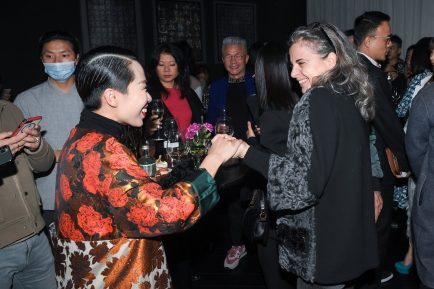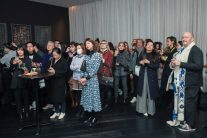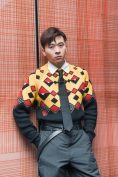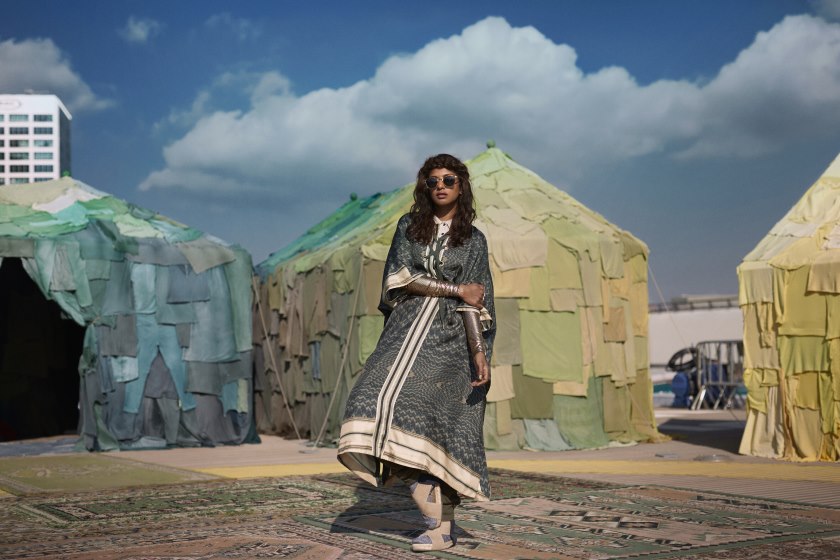
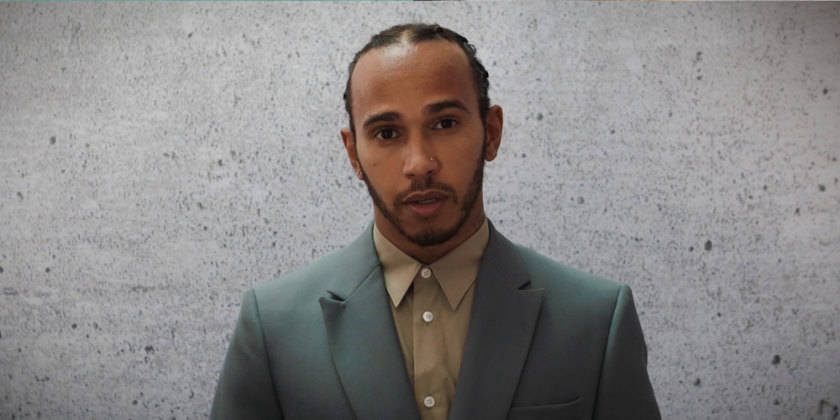

With the UK continuing to deal with the COVID-19 pandemic, the British Fashion Council’s Fashion Awards (formerly the British Fashion Awards) announced its 20 winners with a digital film première.
The 30-minute film went live at www.fashionawards.com today and on YouTube on the BFC’s account, and was screened in selected cities, including Beijing and Shanghai. It features some of the year’s events as well as opinion leaders and young creatives giving their thoughts on its impact. Physically appearing in the film voicing their ideas were photographer Jermaine Francis (on the work of NHS workers), entertainer Miss Jason (on the impact on younger queer people), model Salem Mitchell (on Black Lives Matter, and why activism is important), photographer Lauren Woods (that Black Lives Matter is not a hashtag, but real lives are involved), and photographer Myles Loftin (people of colour are still not represented sufficiently). Wilson Oryema, a writer and activist, followed in a later set (on building a better world for future generations), along with Kasper Kapica, a model and content manager (who recalled doing a Miu Miu campaign in the forest), Bohan Qui, communications director (China in its post-COVID mode and the world’s added interest there), Choom, magazine editor (community in the age of COVID-19), Harry Fisher, store owner (selling virtually this year), and from the class of 2020, Bradley Sharpe (Central St Martin’s), who learned he would not get a graduation show, but it turned into an opportunity.
In the first set of award presentations for communities, Priyanka Chopra Jonas noted that people’s expectations have shifted and that the industry can directly help communities. First to be honoured was the Emergency Designer Network, set up by Bethany Williams, Cozette McCreary, Holly Fulton and Phoebe English. The Network helped create 50,000 surgical gowns and 10,000 sets of scrubs for UK health workers.
Secondly, Michael Halpern eschewed a London Fashion Week show in favour of a tribute to frontline workers, capturing eight women from the public services in film and portraits, and contributed to the production of PPE for the Royal Brompton Hospital.
Chanel has committed to improving the economic and social conditions of women worldwide. Its Foundation Chanel has developed a racial justice fund to support grass roots’ organizations led by people of colour. It has also committed to supporting independent artisans and ateliers. As reported earlier in Lucire, Chanel has also produced PPE. Finally, its climate strategy, Chanel Mission 1·5° aims to reduce its carbon footprint.
Kenneth Ize has supported the communities of weavers, artisans and design groups across Nigeria, placing the country’s heritage on a global stage. He has also celebrated his Blackness and the LGBTQIA+ community with his work.
A Sai Ta, who tells the stories from his east Asian culture through a British lens, has called for the end to discrimination against marginalized communities. His eponymous brand, A Sai, has committed profits to organizations that support the end of systemic discrimination and racism. The brand supported Black Lives Matter, in a manner which the Council labelled ‘exemplary.’
Formula 1 racing driver Lewis Hamilton highlighted the protests against systemic racism in many countries, and believes the fashion industry has a platform on which to make change and creating a more equal society. Hamilton’s set of recipients were people who have led change by encouraging equal, diverse and empowered workforces at all levels of the business.
Edward Enninful was the first recipient in the category, for his work contributing to diversity at British Vogue. The magazine’s covers have featured frontline workers, activists and Black Girl Magic.
Lindsay Peoples Wagner and Sandrine Charles for Black in Fashion Council were next: launched in June 2020, the Council’s aim is to build a foundation for inclusion. It has organized a creatives in the sector to foster the change and create diversity.
Menswear designer Samuel Ross, behind the label A-Cold-Wall, created the Black Lives Matter Financial Aid Scheme, pledging £10,000 to the organizations and people on the frontline supporting the movement. He also awarded grants of £25,000 to black-owned businesses across a diverse range of areas.
Aurora James called on retailers to dedicate 15 per cent of their shelf space to black-owned brands. A controversial winner as far as this magazine is concerned, as James has yet to respond in depth to questions we posed to her in 2017 over a Moroccan artisan’s account, having missed her own deadline by which she promised to provide us with answers.
Finally in this category, Priya Ahluwalia has been a pioneer in sustainable fashion, and a tireless advocate for the black community, especially this year in the wake of the Black Lives Matter movement.
Maisie Williams and Aja Barber presented the awards for the environment, calling on a united effort to making the planet better.
First up among the winners was Stella McCartney, whose record is already well known among consumers and industry alike. She has stayed true to her brand, promoting and practising sustainability, with innovation and circularity.
Anya Hindmarch has worked hard to reduce waste in the fashion supply chain in her business, adopting new techniques and practices. She also supported the NHS with the creation of a holster for frontline staff, as well as reusable and washable hospital gowns.
Christopher Raeburn is a pioneer in the upcycling of surplus fabrics, proving that the designs can still be creative, premium and desirable. He believes that innovation, creativity, technical excellence and partnerships can solve current issues in sustainability.
The Fashion Pact united top-tier fashion CEOs toward collective action on biodiversity and this year, doubled its number of signatories. It represents 200 brands and a third of the industry. It has made its first strides, notably with a digital dashboard of KPIs to measure impact, and with its first collaborative activity on biodiversity.
Gabriela Hearst has sourced materials carefully, looking at where they come from, who makes them, and what impact they have. Her spring–summer 2020 show was the first carbon-neutral catwalk presentation. Hearst wants to make the highest-quality product with the lowest environmental impact.
The last set of awards were for creativity, introduced by Rosalía. Jonathan Anderson was awarded for his innovative approaches to showing fashion for J. W. Anderson and Loewe during the COVID-19 pandemic, with show-in-a-box and show-on-the-wall concepts, as well as inviting people to become part of the show experience.
Grace Wales Bonner’s fashion designs celebrated black culture, evoking its history, and challenged the norms surrounding black masculinity and identity.
Third up were Prada, Miuccia Prada and Raf Simons, demonstrating the importance of conversation, collaboration and dialogue in reimagining fashion for the future.
Riccardo Tisci and Burberry were honoured for their inclusivity and sustainability. The Council noted the label’s innovative use of technology at London Fashion Week in September 2020 and in campaigns and launches. In addition, Burberry donated 160,000 pieces of PPE to the NHS and health care charities, repurposing its trench coat factory in Castleford. It has also donated to aid vaccine research, and to food charities.
Menswear designer Kim Jones, introduced by David Beckham, was recognized for his creativity. He said he felt it was important to bring joy to people in a tough year, and he intended to do so with his fashion.
The Awards were supported by Getty Images, Lavazza, Rosewood London and Royal Salute. The trophy was designed by Nagami and created by Parley for the Oceans using Parley Ocean Plastic.








